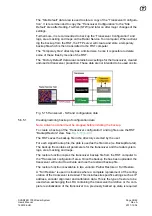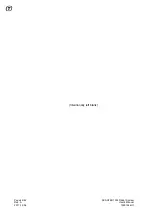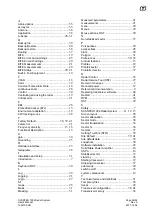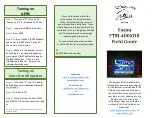
Page 52/62
Rev. A
2017-12-04
SCANTER 1002 Radar System
User’s Manual
1255194-HO
Lack
Lack is a number counting unsuccessful consecutive
updates of a track.
Noise Figure
Noise Figure is defined as the signal-to-noise ratio at the
input divided by the signal-to-noise ratio at the output.
Noise Figure is expressed in dB.
Parameter
A parameter is a quantity which influences the radar vid-
eo, the subsequent signal processing, the plot extraction,
or the target tracking. Examples are: transmitted power,
video sampling rate, video threshold for plot selection, and
expected maximum speed of target.
Plot
A radar plot is a group of connected radar cells in which
the measured video signal exceeds a defined threshold
value and/or fulfils some other discrimination criterion.
Precision
The standard deviation of repeated measurements of the
same quantity under identical conditions i.e. the standard
deviation of the measurements of the range to a fixed ref-
erence target.
Profile
A profile is a set of common operational parameters for
the transceiver and the tracker. Profiles are identified by a
name. When a specific Profile, i.e. Profile Name, is cho-
sen by the operator, all transceiver and tracker parame-
ters are set according to the profile content.
Pulse Compression
For a simple rectangular pulse, the pulse duration is equal
to the reciprocal value of its bandwidth. Improving the
radar sensitivity by increasing pulse duration and thereby
the transmitted power, will have a negative impact on the
range resolution.
Pulse compression, also known as pulse coding, is a sig-
nal processing technique designed to maximise the sen-
sitivity and resolution of a radar system.
By manipulating the amplitude and phase of a pulse, it is
possible to increase the pulse bandwidth, while keeping
the pulse duration unchanged, or vice versa. By doing so,
the increased average transmitted power improves sensi-
tivity while having a high range resolution.
The effectiveness of a particular pulse code is often
judged by its time-bandwidth product. The time-bandwidth
product for a simple rectangular pulse is equal to one. A
compressed pulse might have a time-bandwidth product
of ten. This means that each compressed radar pulse con-
tains ten times the energy of the simple un-coded pulse of
the same resolution. Equivalently, range resolution is ten
times finer than an un-coded pulse of the same duration.











































